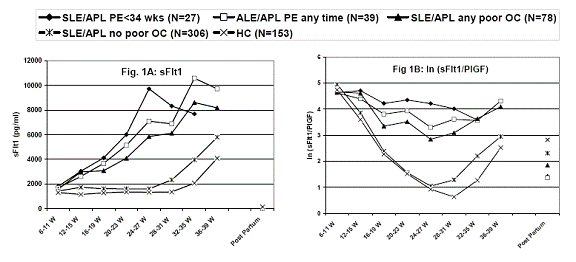Background/Purpose: Pregnant women with lupus and APL are at increased risk for adverse outcomes, particularly preeclampsia (PE), yet identification of those destined for complications remains elusive. Dysregulation of angiogenic factors contributes to pathogenesis of placental insufficiency and preeclampsia. Placentally derived sFlt1 antagonizes proangiogenic proteins (placental growth factor, PlGF; VEGF) which are necessary for development of the placenta and for vascular homeostasis. We prospectively studied patients to determine whether levels of angiogenic factors early in pregnancy would predict outcomes.
Methods: The PROMISSE Study (Predictors of pRegnancy Outcome: BioMarkers In antiphospholipid antibody Syndrome and Systemic Lupus Erythematosus) enrolled 384 pregnant women with ≥4 ACR SLE criteria and/or APL and 153 healthy pregnant controls (HC). Subjects were evaluated and blood collected monthly beginning at <12 wks gestation. Exclusion criteria were multi-fetal pregnancy, prednisone >20mg/d, proteinuria >1gm/24hr, and creatinine >1.2 mg/dL. Poor pregnancy outcomes (OC) were defined as preeclampsia, fetal death, neonatal death, preterm delivery <36 wks because of IUGR or placental insufficiency, and/or growth restriction <5th %ile. Levels of angiogenic factors were measured by ELISA and compared between groups at each time point using Wilcoxon rank sum test. In addition, linear mixed effects models were fit to rank transformed data to estimate and compare rates of change in these factors over the entire gestational period.
Results: PE occurred in 10% of pregnancies (27 at <34 wks; 39 at any time) and other poor outcomes in 10%. Compared to SLE patients without poor OC, levels of sFlt1 (Fig 1A) and sFlt1/PlGF ratios were significantly higher as early as 12-15 wks in those destined for PE or other complications, and remained elevated through 31 weeks. The rate of increase in sFlt1 from 6 wks through 31 weeks was higher in patients with PE (<34 wks, any time) or non-PE OC compared to those without poor OC (p < 0.0001 all comparisons). In contrast, and consistent with impaired placental development, the rate of increase in PlGF was lower in those destined for poor OC (p < 0.0001 all comparisons). Ln sFlt1/PlGF ratios for those who developed PE were markedly and consistently higher throughout pregnancy compared to SLE patients without poor OC or HC (p<0.0005 all comparisons) (Fig 1B). Based on ROC analysis, a ln sFLT1/PlGF ratio cutpoint of 4.14 at the 12-15 wk measure yielded 78% sensitivity and 73% specificity for PE < 34 wk.
Conclusion: We demonstrate that in pregnant SLE and/or APL patients, alterations in the balance of angiogenic factors early in pregnancy are strongly associated with subsequent PE and other poor outcomes. Absolute levels of sFlt1, ratio of sFLt1/PlGF and rate of change of angiogenic factors may be used to identify those at risk before 15 wks, allow early intervention and reveal novel targets for treatment.
Disclosure:
J. E. Salmon,
Roche Pharmaceuticals,
2,
Alexion Pharmaceuticals, Inc., Novartis,
5;
M. Kim,
None;
M. M. Guerra,
None;
M. D. Lockshin,
None;
W. D. Branch,
UCB,
5;
M. Petri,
None;
C. A. Laskin,
None;
J. T. Merrill,
None;
L. R. Sammaritano,
None;
J. P. Buyon,
None;
S. A. Karumanchi,
co-inventor on patents related to PE,
7,
Aggamin llc. ,
1.
« Back to 2013 ACR/ARHP Annual Meeting
ACR Meeting Abstracts - https://acrabstracts.org/abstract/angiogenic-factor-dysregulation-and-risk-of-adverse-pregnancy-outcome-in-lupus-pregnancies/

